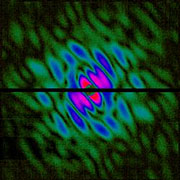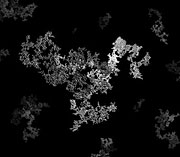- Number 367 |
- July 16, 2012
First detailed images of airborne soot show surprising complexity

Diffraction pattern of a
single soot particle.
(Image by Duane Loh et al)
You may not be able to see them, but tiny airborne particles are everywhere. Tens of millions of kilograms of the smallest particles, known as PM2.5, float over a typical big city in the form of soot, smog, cloud droplets, sea spray and the like. Some types cause health problems when they get into human lungs, while others influence climate by interacting with sunlight.
Now researchers at SLAC National Accelerator Laboratory have captured the most detailed images to date of airborne soot particles, which turn out to have surprisingly complex nanostructures. The discovery could ultimately aid the understanding of atmospheric processes important to climate change, as well as the design of cleaner combustion sources, from car engines to power plants.
The study, published in the June 28, 2012 issue of Nature, also pioneers a method for studying a broad range of individual particles, such as cells or proteins, with highly focused X-ray lasers such as SLAC’s Linac Coherent Light Source (LCLS).
"Our study shows that LCLS can drive a paradigm shift in imaging airborne particles, allowing us to look at them one at a time instead of using a composite of many different particles," said Duane Loh, the lead author of the study and a postdoctoral scholar at SLAC and Stanford University’s PULSE Institute for Ultrafast Energy Science. "We now have a richer imaging tool to explore the connections between their toxicity and internal structure."
Soot and similar particles – especially PM2.5, those 2.5 microns or less in diameter, which are the most dangerous to human health – are difficult to image while airborne. When placed on a surface for examination with a microscope, they tend to clump together and lose their shape.

A new investigation using X-rays
from the Linac Coherent Light
Source has helped researchers
better understand the structure
of airborne soot particles.
These simulated particles,
based on previous research
models, illustrate the expected
fractal structure of soot
particles in the air. The latest
research shows that soot
particles produced as aerosols
can be noticeably denser than
the ones shown here.
(Image by Duane Loh and
Andy Freeberg, SLAC National
Accelerator Laboratory)
In this experiment, researchers created soot particles up to 3.25 microns in diameter and wafted them into the path of the LCLS laser beam. Its laser pulses are so brief that they capture enough information to make an image in the quadrillionths of a second before a particle blows apart.
They found that no two particles are alike. Like magnified snowflakes, soot particles show similar patterns of complexity at different scales, which is characteristic of fractals.
The results make scientists wonder what diversity of forms will be discovered if particles produced in real-world, "messy" environments, such as a car's combustion engine or a candle flame, are imaged one at a time. The team is analyzing data from experiments at the LCLS that examined soot from diesel emissions as well as other types of airborne particles.
In fact, in the real world PM2.5 particles are seldom pure. They get coated with volatile compounds given off by plants, and collisions with other particles can change their structure and chemistry. To mimic these changes, the researchers added salt spray to their manufactured soot particles and examined them in the LCLS beam. The result: they could clearly tell the difference between soot, salt and a mixture of both.
A primary long-term goal of the research is to take snapshots of airborne particles as they change their size, shape and chemical make-up in response to their environment, said Michael Bogan, a staff scientist at PULSE and leader of the international research team.
"Scientists can now imagine being able to watch the evolution of soot formation in combustion engines from their molecular building blocks, or maybe even view the first steps of ice crystal formation in clouds,” he said.
The research team included contributors from SLAC, DESY, Lawrence Berkeley National Laboratory, the Max Planck Institutes, the National Energy Research Scientific Computing Center, Lawrence Livermore National Laboratory, Cornell University, the University of Hamburg, Synchrotron Trieste and Uppsala University. LCLS is supported by DOE’s Office of Science.[Glennda Chui, 650.926.4897,
glennda@slac.stanford.edu]
